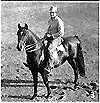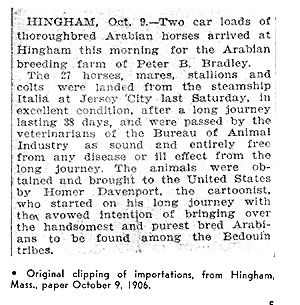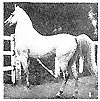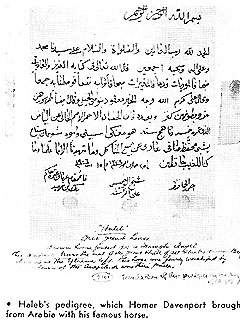 DAVENPORT,
the man of enviable attainments, at heart was an idealist and dreamer.
He became the champion of the Arabian horse in America, declaring that
the horses of the desert, fed on the poorest and scantiest herbs, never
taken under shelter out of storms or heat, who went on thousand-mile raids,
were still remarkable for their beauty, intelligence and perfection of
build; for in the desert they must be not only survivors of the fittest,
but paragons of excellence and quality. Davenport believed that we in America
would do well to acquire such horses to improve or retain qualities in
our Stock Horses, Indian and Cowponies, Morgans and Saddle horses in general. DAVENPORT,
the man of enviable attainments, at heart was an idealist and dreamer.
He became the champion of the Arabian horse in America, declaring that
the horses of the desert, fed on the poorest and scantiest herbs, never
taken under shelter out of storms or heat, who went on thousand-mile raids,
were still remarkable for their beauty, intelligence and perfection of
build; for in the desert they must be not only survivors of the fittest,
but paragons of excellence and quality. Davenport believed that we in America
would do well to acquire such horses to improve or retain qualities in
our Stock Horses, Indian and Cowponies, Morgans and Saddle horses in general.
HOMER DAVENPORT's father was an Indian agent
of the old West. The passion for horses and the people of the plains were
in Homer Davenport's blood when he went to desert Arabia.
THE TASK of bringing horses directly from Arabia
to America was not easy, but with the assistance of Theodore Roosevelt,
President of the United States, applications were made to His Imperial
Majesty the Sultan of Turkey, asking for an Irade, or export permit for
a number of stallions and mares from the desert. In June 1906 the permission
was granted and in due time Homer Davenport and his two companions set
out on their pilgrimage. After reaching Aleppo they began their quest in
the desert of northern Arabia and Syria in which the famous Hashem Bey,
the Shaykh of all Sheikhs, played a most romantic and helpful role.
HASHEM BEY was the distant
but direct descendent of that renowned Fid'an Chief who, two hundred years
earlier, sold to his friend, Mr. Darley, (at that time British Consul in
Aleppo), the desert-bred stallion Manak (mentioned in my last article on
the Mu'niqiyat breeding) -- the sire of Flying Childers and foundation
sire of the Eclipse line of Thoroughbreds.
 AMONG
THE animals which Homer Davenport brought to the U.S.A. was a pure-in-the-strain
Mu'niqi-Hadruj. This horse was Kusof, a two year old stallion of the Darley
Arabian race-strain. What a lucky find! I roamed the deserts of Arabia
on and off for over twenty-five years and was never able to acquire a pure-in-the-strain
Mu'niqi-Hadruj. AMONG
THE animals which Homer Davenport brought to the U.S.A. was a pure-in-the-strain
Mu'niqi-Hadruj. This horse was Kusof, a two year old stallion of the Darley
Arabian race-strain. What a lucky find! I roamed the deserts of Arabia
on and off for over twenty-five years and was never able to acquire a pure-in-the-strain
Mu'niqi-Hadruj.
THE TRAGEDY however is that Kusof was never
mated with a mare of the Mu'niqi-Hadruj strain, though several pure-bred
Mu'niqiyah-Hadrujiyah mares of Randolph Huntington were still alive in
America at that time. Kusof was only used three times to Arabian mares
in fifteen years (1908-1923) and all three belonged to other strains
(not the Mu'niqiyat).
FORTUNATELY Homer Davenport had purchased twenty-six
other horses besides Kusof. Davenport owned his acquisition to Shaykh Ahmed
Hafiz, a Bedouin diplomat and political representative of many tribes in
Aleppo. This important Bedouin agent, though an old man, was "famed
as a horseman of the highest rank, and versed in pedigrees second to none."
 HOMER
DAVENPORT journeying with Ahmed Hafiz among the tribes in quest
of Arabian horses, became his blood-brother in a scared ceremony. After
that Ahmed Hafiz saw to it that Davenport was well treated and that only
outstanding horses of distinguished lineage were bought. They were the
choice of the desert, the priceless heritage of the Bedouins, from which
they never would have parted for less than their friendship and loved of
this old Bedouin-brother of Homer Davenport. HOMER
DAVENPORT journeying with Ahmed Hafiz among the tribes in quest
of Arabian horses, became his blood-brother in a scared ceremony. After
that Ahmed Hafiz saw to it that Davenport was well treated and that only
outstanding horses of distinguished lineage were bought. They were the
choice of the desert, the priceless heritage of the Bedouins, from which
they never would have parted for less than their friendship and loved of
this old Bedouin-brother of Homer Davenport.
HOMER DAVENPORT brought to the U.S.A. six pure-in-the-
strain- bred Arabian horses (Kusof-Reshan-Abeyah-Urfah-Jedah) and three
in related type and strain (Houran-Wadduda-Moharra). Eleven other Arabs
were of related classic strains and three whose sires are not mentioned
in our studbooks (and cannot classify therefore). Only four of the twenty-seven
horses were of mixed strains. This record alone should prove that the majority
of horse breeders among the Bedouins in 1906 were still breeding pure-in-the-strain
or within the classic strains.
 WITHOUT
EXAGGERATION it may be said today (more than thirty
years later) that Homer Davenport's Arabians and their offspring have become
the pride and heritage of America too. There are hundreds of Americans
who own Arabs out of Homer Davenport's importation. Twenty-seven stallions
and mares formed the little herd of desert steeds that landed on the shores
of America in 1906; but today they have grown into a mighty herd which
has been registered and whose breeding is the serious concern of many men
and women in our country. Every year there are millions of Americans who
watch Arabians perform, not only in horse shows and rodeos, on ranches
and over bridle paths, but in motion pictures, too -- and most of these
handsome creatures carry some blood of Homer Davenport's almost forgotten
importation. WITHOUT
EXAGGERATION it may be said today (more than thirty
years later) that Homer Davenport's Arabians and their offspring have become
the pride and heritage of America too. There are hundreds of Americans
who own Arabs out of Homer Davenport's importation. Twenty-seven stallions
and mares formed the little herd of desert steeds that landed on the shores
of America in 1906; but today they have grown into a mighty herd which
has been registered and whose breeding is the serious concern of many men
and women in our country. Every year there are millions of Americans who
watch Arabians perform, not only in horse shows and rodeos, on ranches
and over bridle paths, but in motion pictures, too -- and most of these
handsome creatures carry some blood of Homer Davenport's almost forgotten
importation.
 MUSON
one of Davenport's Desert Arabs, created a sensation at his appearance
in Madison Square Garden in 1907 when Colonel Cody (Buffalo Bill) mounted
him at the opening of his "Congress of Wild Riders and Wild West
Show." President Theodore Roosevelt and his guests paid homage
ot this great horse, "which fulfilled the fanciful picture that
one has in mind when you mention Arabian horses." (Muson was a
Kuhaylan, sired by a Shuwayman who belongs to the same classic antique
type as the Kuhaylan). a more powerful and at the same time such a graceful
horse never had been seen, gentle, alert and of beautiful symmetrical proportions.
One of the unforgettable impressions created by Muson was when a full-blooded
Indian, seventy-two year old "Bull Bear," High Chief of the Cheyennes
mounted him and gave an exhibition of bareback riding. The old warrior
of the plains handled the high-spirited Arabian stallion without effort,
sitting erect and stern in his place, a noble red man. MUSON
one of Davenport's Desert Arabs, created a sensation at his appearance
in Madison Square Garden in 1907 when Colonel Cody (Buffalo Bill) mounted
him at the opening of his "Congress of Wild Riders and Wild West
Show." President Theodore Roosevelt and his guests paid homage
ot this great horse, "which fulfilled the fanciful picture that
one has in mind when you mention Arabian horses." (Muson was a
Kuhaylan, sired by a Shuwayman who belongs to the same classic antique
type as the Kuhaylan). a more powerful and at the same time such a graceful
horse never had been seen, gentle, alert and of beautiful symmetrical proportions.
One of the unforgettable impressions created by Muson was when a full-blooded
Indian, seventy-two year old "Bull Bear," High Chief of the Cheyennes
mounted him and gave an exhibition of bareback riding. The old warrior
of the plains handled the high-spirited Arabian stallion without effort,
sitting erect and stern in his place, a noble red man.
 LETAN
, whom I bought for the Kellogg ranch in 1925, was a son of Muson. Letan
became famous as a stock and show horse in the West. Will Rogers, lover
of horses had a special fondness for Letan and rode him on his ranch and
in his movie pictures. LETAN
, whom I bought for the Kellogg ranch in 1925, was a son of Muson. Letan
became famous as a stock and show horse in the West. Will Rogers, lover
of horses had a special fondness for Letan and rode him on his ranch and
in his movie pictures.
 ANOTHER
ONE of Homer Davenport's Arabians was Haleb, whose parents were
a combination of the Shuwayman strain (known for strength and beauty) and
his dam of the Mu'niqi-Sbaili (fast, but not so angular as the Mu'niqi-Hadruj).
(The Sbaili are more handsome too.) Strength, beauty and speed were qualities
which had created Justin Morgan's fame in his time, making the ideal combination
horse of greatest utility and all-purpose. Haleb was a horse of this Morgan
type. He was first shown to Homer Davenport in the palace grounds of Nazim
Pasha, Governor of Aleppo on the sixth day of August 1906. Haleb was of
such fame that "Town-Arabs" like Prince Rashid of Hayil and Emir
of Riyad who were not fanatic "Purists" (breeders of one particular
pure strain) but just horse-fanciers who liked a good horse, sent from
the distant south their mares under special convoy to Syria to breed to
Haleb. ANOTHER
ONE of Homer Davenport's Arabians was Haleb, whose parents were
a combination of the Shuwayman strain (known for strength and beauty) and
his dam of the Mu'niqi-Sbaili (fast, but not so angular as the Mu'niqi-Hadruj).
(The Sbaili are more handsome too.) Strength, beauty and speed were qualities
which had created Justin Morgan's fame in his time, making the ideal combination
horse of greatest utility and all-purpose. Haleb was a horse of this Morgan
type. He was first shown to Homer Davenport in the palace grounds of Nazim
Pasha, Governor of Aleppo on the sixth day of August 1906. Haleb was of
such fame that "Town-Arabs" like Prince Rashid of Hayil and Emir
of Riyad who were not fanatic "Purists" (breeders of one particular
pure strain) but just horse-fanciers who liked a good horse, sent from
the distant south their mares under special convoy to Syria to breed to
Haleb.
Haleb originally was born among the Saba' tribe and presented as
a token of appreciation to Turkish Governor of Syria who had shown unusual
fairness in dealing with the children of the desert.
 DAVENPORT
rode his priceless horse over two hundred mikles from Aleppo into the desert
to meet the people who had raised Haleb. The tribesmen gathered from all
ends of the wilderness to pay tribute to the horse that had been honored
by both rulers of Arabia and the Turkish Governor of Syria. The Bedouins
bowed down to the ground as they bade farewell to their beloved steed.
Some cried, men of the desert, unashamed, who did not hold back their tears. DAVENPORT
rode his priceless horse over two hundred mikles from Aleppo into the desert
to meet the people who had raised Haleb. The tribesmen gathered from all
ends of the wilderness to pay tribute to the horse that had been honored
by both rulers of Arabia and the Turkish Governor of Syria. The Bedouins
bowed down to the ground as they bade farewell to their beloved steed.
Some cried, men of the desert, unashamed, who did not hold back their tears.
ON JUNE 17, 1907, Haleb (a seal brown without
a white hair), won first prize in the Justin Morgan class at the Rutland,
Vermont, horse show, competing with and winning over the best Morgans on
their own home grounds. Haleb was conceded to be the most remarkable horse.
Horse breeders considered him "the salvation of the Morgan breed".
But tragedy was soon to follow on the heels of this historical event. With
the Justin Morgan cup his prized possession, Homer Davenport lost his invaluable
horse. A few days later Haleb died -- supposedly poisoned.
 ALWAYS
REMEMBERED by American breeders will be Wadduda, mother of Moliah
and eight other well known fillies and colts in the American Stud book
of Arabian horses. Wadduda, Hashem Bey's own war-mare with large lustrous
eyes was not only celebrated for her beauty, but her courage. Two large
scars on her neck bore witness to a deadly duel which her master had fought
from her back, when he unhorsed a chieftain of the Ruala tribe and two
slaves of the dying master thrust the steel blades of their lances into
her. At another time Wadduda proved her great endurance when she was ridden
from Alexandretta to Aleppo, 106 miles in eleven hours over high mountain
trails. Hashem Bey's love for Wadduda was not exceeded by that for his
family, but he turned his war-mare over to Shaykh Ahmed hafiz as a token
of their friendship and respect for each other. When Davenport came to
Aleppo, it was Shaykh Ahmed Hafiz's turn to give the famous war-mare away.
Taking leave from her, Ahmed Hafiz pointed to a blue bead which Hashem
Bey had tied into Wadduda's tail when she was born and said to Davenport:
"I love even this little talisman fastened into her long hair, but
from now on Wadduda is the possession of my brother and the blue Bead will
be a token of her noble birth." ALWAYS
REMEMBERED by American breeders will be Wadduda, mother of Moliah
and eight other well known fillies and colts in the American Stud book
of Arabian horses. Wadduda, Hashem Bey's own war-mare with large lustrous
eyes was not only celebrated for her beauty, but her courage. Two large
scars on her neck bore witness to a deadly duel which her master had fought
from her back, when he unhorsed a chieftain of the Ruala tribe and two
slaves of the dying master thrust the steel blades of their lances into
her. At another time Wadduda proved her great endurance when she was ridden
from Alexandretta to Aleppo, 106 miles in eleven hours over high mountain
trails. Hashem Bey's love for Wadduda was not exceeded by that for his
family, but he turned his war-mare over to Shaykh Ahmed hafiz as a token
of their friendship and respect for each other. When Davenport came to
Aleppo, it was Shaykh Ahmed Hafiz's turn to give the famous war-mare away.
Taking leave from her, Ahmed Hafiz pointed to a blue bead which Hashem
Bey had tied into Wadduda's tail when she was born and said to Davenport:
"I love even this little talisman fastened into her long hair, but
from now on Wadduda is the possession of my brother and the blue Bead will
be a token of her noble birth."
DAVENPORT had to accept not only Wadduda but
her personal slave, who had come as a gift with the mare from the great
Shaykh Hashem Bey to Ahmed Hafiz. Robed in his Nomad Arab's shepherd coat,
Said 'Abdallah became a picturesque figure wherever the Davenport horses
were shown. Said was a great horseman and a match for any rider in America.
 IN
1924, I acquired Jadaan, a famous grandson of Wadduda from Peter B. Bradley
(old friend and partner of Homer Davenport) and brought the stallion to
California. I rode Jadaan for years and also "doubled" on him
for Rudolph Valentino as the old and the young chief in the photoplay of
the "Son of the Sheik." IN
1924, I acquired Jadaan, a famous grandson of Wadduda from Peter B. Bradley
(old friend and partner of Homer Davenport) and brought the stallion to
California. I rode Jadaan for years and also "doubled" on him
for Rudolph Valentino as the old and the young chief in the photoplay of
the "Son of the Sheik."
ON APRIL 13th, Jadaan will be twenty-six years
of age. he is still shown on the Kellogg Ranch near Pomona, California
and has often been seen as mount of the Grand Marshal of the Tournament
of Roses Parade in Pasadena, and at other fairs in California. Visitors
comment on Jadaan's "natural" grace and "conscious"
pride to show off and display his beauty and style. It must be in his blood
-- he is a Saqlawi (the "Beauty" stain and type).
JADAAN was one of the eleven Arabians of pure
Davenport descent (four stallions and seven mares) which I had collected
in various states of America and brought to California in 1924. A year
later these eleven Davenport Arabians became the foundation stock of the
Kellogg Ranch, Pomona.
IN 1926 I brought to America, fourteen Arabians
from Lady Anne Blunt's historical Crabbet Park Stud. Among them Nasik,
Raseyn, Rossana, Rifla, Rasima, Raida, Ferda and other so-called "double-registered"
Arabians. With pardonable pride I may say that of the original twenty-five
Arabians which I brought to California in 1924 and 1926, every one has
made its name in horse breeding. Their descendants (hundreds of them) are
found all over America today and even in distant parts of the world where
they have been exported to. But if you ask me who is to be "blamed"
for it all I must decline the responsibility and point again to Homer Davenport
for whom we feel a lasting gratitude that he saved the Arabian horse in
America and thus helped to improve our Stock Horses continually.
(In the next article Mr. Raswan will deal with our so-called "Double-Registered
Arabians.")
 Jadaan,
Carl Raswan and Rudolph Valentino during the filming of th epic picture
"The Son of the Sheik,"near Yuma, Arizona, in June, 1926. Jadaan
is by a Davenport horse. Jadaan,
Carl Raswan and Rudolph Valentino during the filming of th epic picture
"The Son of the Sheik,"near Yuma, Arizona, in June, 1926. Jadaan
is by a Davenport horse.
  
Father, son and grandson. 1, Muson, brought by Davenport;
2, Letan, a horse used by Will Rogers; 3. Oriental, still
living.
 Wadduda,
the famous war mare of the desert, and her foal, Mekka, with Said Abdallah,
the Bedouin slave. Wadduda,
the famous war mare of the desert, and her foal, Mekka, with Said Abdallah,
the Bedouin slave.
 Homer
Davenport with Ibn Mahruss (later owned by Anita Baldwin). Homer
Davenport with Ibn Mahruss (later owned by Anita Baldwin).
   
Some of the outstanding horses imported by Homer Davenport.
1, Haleb; 2, Hamrah; 3. Kusof; 4. Hejas.
Many modern-day pedigrees trace to these animals.
Haleb's pedigree, which Homer Davenport brought from Arabia with
his famous horse.
 TRANSLATION: TRANSLATION:
IN THE NAME
OF THE MOST
MERCIFUL ALLAH: Praise be to
Allah, the Lord of the Universe, and prayers and greetings upon our Master
Muhammad, and upon all his family and his followers.
God, the All-High, has said in his cherished Book: By those which
run swiftly with a panting noise, and which strike fire, and which make
an incursion in the morning, raising a cloud of dust and piercing the ranks
of a host."Also, Ali, may God bathe his face with Glory, has said:
Plenty is knotted to the horse's manes.": He has also said: "(On)
Their backs are splendor and (in) their wombs are treasure." And now:
The pure brown stallion who is devoid of white and whose age is five years,
going on his sixth, is a MANAKHY SABILY.
His sire is a SHUWAYIMAN SABBAH,
who breeds pure and exclusive, and is consequently free of all defects.
-- and we have not testified except to what we have known, and we are incognizant
of the unknown. -- written the 25th of HAMADA, the
last, 1324 (HEGIRA) and the 15th of August, 1906 A.D.
(Signed) Ahmad Hafiz (Signed) Sheikh el-Bukhamis Ali Al-Rashid (Signed)
Kaimakam Hagim Bey Menhad
|
![]()
![]()
![]()